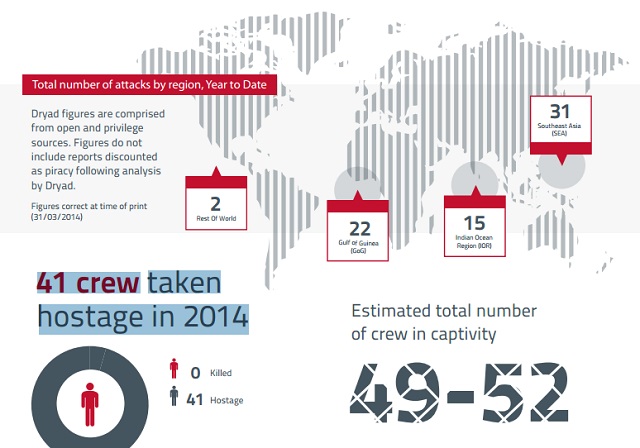70 Pirate Attacks in 2014 So Far -Dryad
41 crew taken hostage in 2014
Dryad’s quarterly figures on maritime crime incidents reveal a steady cadence of all types of crime across three main areas, namely the Gulf of Guinea, Horn of Africa and Southeast Asia. Whilst the numbers do not point to a significant increase when compared to the same period last year, there have been some notable events that give continued cause for concern for the shipping industry.
In the Gulf of Guinea, a spike in kidnap of crew for ransom off the Niger Delta has illustrated the very real threat to vessels operating in this region, whilst the Nigerian criminal gang hijack of a product tanker from an Angolan anchorage, over 800 miles from the Niger Delta, has potentially sent a shock wave across the Atlantic Ocean. The kidnap threat has drawn little media attention, despite the spate of incidents that have seen a large number of seafarers kidnapped and released, although Dryad has highlighted the problem to the wider shipping community. At the time of writing, six seafarers are believed to remain in the hands of their captors. In a different type of crime, the hijack of MT Kerala from its Angolan anchorage with a subsequent theft of 13,000 tons of gasoil off the Niger Delta, has demonstrated the increasingly significant reach of Nigerian-based criminals, albeit that some commentators remain in denial, believing the whole event to be a crew-inspired fraud; not our view!
In the Horn of Africa, the incident numbers are slightly up on the same period last year but mainly due, in our view, to a fair amount of misreporting and misinterpretation of events. From reported attacks subsequently downgraded to suspicious approaches to the misidentification of regional fishermen in the Southern Red Sea and off the coast of Oman, we have seen a number of non-piratical events make it into IMB and other reporting during the first quarter of the year. Whilst the quarter ended with shots fired against a vessel in the Strait of Hormuz, this has been categorized as non-piratical and was more likely related to out of control regional forces or an armed smuggler. Despite the above, it should not be forgotten that we have witnessed actual acts of maritime crime in the January to March period and that Somali pirates have not been totally eradicated. Armed attacks against MT Nave Atropos, south of Salalah in January and the Kenyan vessel, MV Andrea, close to the Somali coast in February have proved that broad containment of the threat does not mean it has been removed. On both occasions, the Somali attackers were repelled by embarked armed security teams on the vessels concerned.
The waters of Southeast Asia have continued to lead the statistics in 2014, albeit with lower levels of activity than in the same period in 2013. As with the Gulf of Guinea, whilst the figures are slightly lower, we have noted some worrying instances of crime in certain areas with what could be a connected reduction in others. The Singapore Strait has attracted attention with a number of vessels boarded for robbery in the first quarter of the year; a spate of attacks that has coincided with a reduction of incidents in the anchorages off Pulau Nipah, possibly signalling a change of modus operandi for criminal gangs who may have shifted attention to boarding vessels underway. Southeast Asia cargo theft may also have reared its head in 2014, with a possible attack on a product tanker in the Malacca Strait.

In summary, maritime crime continues across the globe. Whilst Dryad’s figures show an overall 13% reduction when compared to the same three-month period in 2013, we have seen a number of developments that give cause for concern and serve as a reminder to all to remain vigilant and employ appropriate risk reduction measures in all high risk areas. Dryad’s latest figures show that maritime criminals, from those off Nigeria to Somali pirates and those that operate in the archipelago of Southeast Asia remain very much in business and are capable of inflicting misery on seafarers. The first line of defense is to be aware of their presence and take measures to ensure that their nefarious activities are countered.
